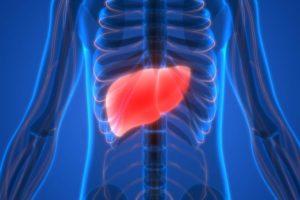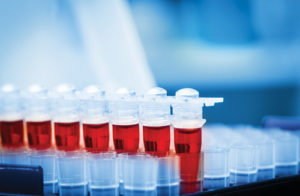Liver Fibrosis Samples
Bay Biosciences provides high quality, clinical grade, liver fibrosis FFPE biopsy tissue blocks bio-specimens and matched cryogenically preserved sera (serum), plasma and peripheral blood mononuclear cells (PBMC) biofluid samples from patients diagnosed with liver fibrosis.
The sera (serum), plasma and PBMC biofluid specimens are processed from liver fibrosis patient’s peripheral whole-blood using customized collection and processing protocols. The liver fibrosis biopsy tissue and matched biofluid samples are collected from unique patients diagnosed with liver fibrosis and are provided to a valued pharmaceutical customer for research, diagnostics, discovery and drug development.
Detailed clinical data, patients history, symptoms, complete blood count (CBC), serology, MRI, biopsy tissue, histopathology information, elevated biomarker levels, genetic and metabolic information associated with liver fibrosis specimens is provided to a valued customer for research, development and drug discovery.
The liver fibrosis sera (serum), plasma and peripheral blood mononuclear cells (PBMC) biofluid are processed from patients peripheral whole-blood using customized collection and processing protocols.

Liver Fibrosis Overview
Liver fibrosis occurs when repetitive or long-lasting injury or inflammation causes excessive amounts of scar tissue to build up in the organ. Most types of chronic liver disease can eventually cause fibrosis. Liver fibrosis occurs when the healthy tissue of your liver becomes scarred and therefore cannot work as well. Fibrosis is the first stage of liver scarring. Later, if more of the liver becomes scarred, it’s known as liver cirrhosis.
Unlike healthy liver cells, scar tissue cells cannot self-repair or otherwise function. As a result of this, fibrosis can reduce overall liver function and impair the organ’s ability to regenerate. Scar tissue from fibrosis can also block or limit the flow of blood within the liver. This can starve and eventually kill healthy liver cells, creating more scar tissue in the process. Treatment tends to involve clearing infections, making lifestyle changes, and taking certain medications. This can often reverse the damage of mild to moderate liver fibrosis. If inflammation continues, possibly because a person has not received treatment, liver fibrosis can develop into more serious liver conditions.
Stages of Liver Fibrosis
There are several different scales of liver fibrosis staging, where the degree of liver damage is determined by experts. Since staging can be subjective, each scale has its own limitations. One doctor may think a liver is slightly more scarred than another. However, doctors will usually assign a stage to liver fibrosis because it helps the patient and other doctors understand the degree to which a person’s liver is affected.
One of the more popular scoring systems is the METAVIR scoring system. This system assigns a score for “activity” or the prediction of how fibrosis is progressing, and for the fibrosis level itself. Doctors can usually assign this score only after taking a biopsy tissue sample of a piece of the liver. The activity grades range from A0 to A3:
- A0: No activity
- A1: Mild activity
- A2: Moderate activity
- A3: Severe activity
The fibrosis stages range from F0 to F4:
- F0: no fibrosis
- F1: portal fibrosis without septa
- F2: portal fibrosis with few septa
- F3: numerous septa without cirrhosis
- F4: Cirrhosis
Therefore, a person with the most severe disease form would have an A3, F4 METAVIR score.
Another scoring system is Batts and Ludwig, which grades fibrosis on a scale of grade 1 to grade 4, with grade 4 being the most severe. The International Association of the Study of the Liver (IASL) also has a scoring system with four categories that range from minimal chronic hepatitis to severe chronic hepatitis.

Signs and Symptoms of Liver Fibrosis
Patients with liver fibrosis are usually unaware that they have it, this is because it rarely causes any obvious symptoms. When a patients does progress in their liver disease, they may experience the following symptoms:
- Reduced overall liver function, including the purifying of blood, storing of energy, and clearing of infections
- Limited ability of the liver to regenerate
- Restrict blood flow within the liver
Liver fibrosis patients usually start to experience signs and symptoms when fibrosis progresses to cirrhosis. These initial symptoms can vary, but following are some of the common indicators of early cirrhosis:
- Nausea
- Vomiting
- a poor appetite
- Weakness
- Fatigue
- Exhaustion
- Weight loss
- Discomfort or mild pain
- Pain in the upper right abdomen
Following are some of the common signs of more advanced cirrhosis:
- Tendency to bruise or bleed easily
- Edema or fluid retention in the lower legs, ankles, or feet
- Jaundice which is a yellowing of the skin and eyes
- Ascites or abdominal bloating from a buildup of fluid
- Itchy skin
- Increased sensitivity to medications and their side effects
- Problems with certain cognitive functions, such as memory, concentration, or sleeping
- Darkening of the urine
Causes of Liver Fibrosis
Liver fibrosis occurs after a patient experiences injury or inflammation in the liver. The liver’s cells stimulate wound healing. During this wound healing, excess proteins such as collagen and glycoproteins build up in the liver. Eventually, after many instances of repair, the liver cells (known as hepatocytes) can no longer repair themselves. The excess proteins form scar tissue or fibrosis.
Following are several types of liver diseases that can cause liver fibrosis:
- Autoimmune hepatitis
- Biliary obstruction
- Iron overload
- Nonalcoholic fatty liver disease, which includes nonalcoholic fatty liver disease (NAFLD) and nonalcoholic steatohepatitis (NASH)
- Viral hepatitis B and C
- Alcoholic liver disease
Diagnosis of Liver Fibrosis
Liver Biopsy
Traditionally, doctors considered taking a liver biopsy the “gold standard” of testing for liver fibrosis. This is a surgical procedure where a doctor would take a tissue sample. A specialist known as a pathologist will examine the tissue for the presence of scarring or fibrosis.
Transient Elastography (Fibroscan)
Another option is an imaging test known as transient elastography (Fibroscan). This is a test that measures how stiff the liver is. When a patient has liver fibrosis, the scarred cells make the liver stiffer. Transient elastography (Fibroscan) test uses low-frequency sound waves to measure how stiff liver tissue is. However, it’s possible to have false positives where the liver tissue may appear stiff, but a biopsy doesn’t show liver scarring.
Nonsurgical Tests
There are other tests available that don’t require surgery to determine the likelihood a patient may have liver fibrosis. These blood tests are usually reserved for those with known chronic hepatitis C infections who are more likely to have liver fibrosis due to their disease. Examples include serum hyaluronate, matrix metalloproteinase-1 (MMP), and tissue inhibitor of matrix metalloproteinase-1 (TIMP-1).
Doctors may also use tests that require calculations, such as an aminotransferase-to-platelet ratio (APRI) or a blood test called FibroSURE that measures six different markers of liver function and puts them into an algorithm before assigning a score. However, a doctor can’t usually determine the stage of liver fibrosis based on these tests. Ideally, a doctor will diagnose a person with liver fibrosis at an earlier stage when the condition is more treatable.
Treatment of Liver Fibrosis
Treatment options for liver fibrosis usually depend upon the underlying cause of the fibrosis. Doctors will treat the underlying illness, if possible, to reduce the effects of liver disease. For example, if a person drinks alcohol excessively, a doctor may recommend a treatment program to help them stop drinking. If a person has NAFLD, a doctor may recommend making dietary changes to lose weight and taking medications to promote better blood sugar control. Exercising and losing weight may also help to reduce the disease’s progression.
A doctor may also prescribe medications known as antifibrotics, which have been shown to reduce the likelihood that liver scarring will occur. The antifibrotic prescribed usually depends on the underlying medical condition. Examples of these treatments include:
- Chronic Liver Disease: ACE inhibitors, such as benazepril, Lisinopril, and ramipril
- Hepatitis C Virus: a-Tocopherol or interferon-alpha
- Nonalcoholic Steatohepatitis: PPAR-alpha agonist
If a patients liver fibrosis advances to where their liver is very scarred and doesn’t work, a patient’s only treatment is often to receive a liver transplant. However, the waiting list is long for these transplant types and not every patient is a surgical candidate.
Successfully treating the cause of early to moderate liver fibrosis may reverse most, if not all, of the damage that the fibrosis has caused. Nearly every chronic liver condition eventually results in fibrosis, as each condition causes lasting inflammation in the liver. This inflammation can lead to the formation of scar tissue, which is fibrous.
The most common causes of liver fibrosis in the U.S. are:
- Chronic alcohol abuse
- Viral hepatitis C or B
- Nonalcoholic fatty liver disease (NAFLD)
- Nonalcoholic steatohepatitis (NASH), a subtype of NAFLD
NAFLD and NASH tend to develop in patients with excess weight, diabetes, or prediabetes and high levels of fat and cholesterol circulating in the blood. Doctors refer to the latter condition as metabolic syndrome.
Other common causes of liver fibrosis include:
- Hemochromatosis or an excess of iron
- Wilson’s disease, which causes copper to accumulate in the body
- Bile duct obstructions
- Chronic Heart disease
- Autoimmune Hepatitis
Certain medications can also lead to liver fibrosis, including:
- Amiodarone
- Chlorpromazine
- Methotrexate
- Tolbutamide
- Isoniazid
- Methyldopa
- Oxyphenisatine
Once the root cause of liver fibrosis is identifies, a specific course of treatment will start. Some of the most common treatments involve the following:
- Stopping or limiting alcohol use and using supportive therapies to help with this in the long-term
- Treatment of chronic viral hepatitis infections with antiviral medications
- Treating NAFLD and NASH by balancing the diet, losing at least 7% of the body weight over 1 year, and controlling blood levels of fat, cholesterol, and sugar
- Start medications that remove heavy metals, such as iron and copper, from the body
- Dissolving or removing bile duct obstructions
- Stopping the use of medications linked with fibrosis
- Taking medications that reduce the activity of the immune system
Scientists have yet to develop medications that directly reverse or treat the damage associated with liver fibrosis. However, research into antifibrotic drugs, which will reduce or prevent the fibrotic process, is ongoing. Scientists are also looking for better ways to treat certain causes of liver fibrosis, such as alcohol use or NASH. For example, research has preliminarily shown the type 2 diabetes medication pioglitazone to improve NASH in patients who do not have diabetes.
Beyond conventional medications, research shows that a few natural remedies may also help reduce fibrosis in certain circumstances. Some of these remedies include:
- Drinking a moderate amount of coffee
- Staying hydrated
- Taking milk thistle, which contains high levels of the antioxidant silymarin (doctors do not recommend this for people taking hepatitis C medications)
- Taking vitamin E for NASH
When a patient has advanced liver fibrosis or cirrhosis, they often require additional forms of treatment, and liver damage is generally irreversible.
Common treatment options for advanced fibrosis or cirrhosis include:
- Taking medications to remove excess fluid from the body
- Limiting salt intake
- Taking medications to remove toxins from the brain
- Taking medications that reduce pressure in the veins of the stomach and esophagus
- Having transplantation surgery to replace the damaged liver with a healthy one from a donor

Bay Biosciences is a global leader in providing researchers with high quality, clinical grade, fully characterized human tissue samples, bio-specimens and human bio-fluid collections from cancer (tumor) tissue, cancer serum, cancer plasma cancer PBMC and human tissue samples from most other therapeutic areas and diseases.
Bay Biosciences maintains and manages it’s own bio-repository, human tissue bank (biobank) consisting of thousands of diseased samples (specimens) and from normal healthy donors available in all formats and types. Our biobank procures and stores fully consented, deidentified and institutional review boards (IRB) approved human tissue samples and matched controls.
All our human human tissue collections, human specimens and human bio-fluids are provided with detailed samples associated patient’s clinical data. This critical patient’s clinical data includes information relating to their past and current disease, treatment history, lifestyle choices, biomarkers and genetic information. Patient’s data is extremely valuable for researchers and is used to help identify new effective treatments (drug discovery & development) in oncology, other therapeutic areas and diseases. This clinical information is critical to demonstrate their impact, monitor the safety of medicines, testing & diagnostics, and generate new knowledge about the causes of disease and illness.
Bay Biosciences banks wide variety of human tissue samples and biological samples including cryogenically preserved -80°C, fresh, fresh frozen tissue samples, tumor tissue samples, FFPE’s, tissue slides, with matching human bio-fluids, whole blood and blood derived products such as serum, plasma and PBMC’s.
Bay Biosciences is a global leader in collecting and providing human tissue samples according to the researchers specified requirements and customized, tailor made collection protocols. Please contact us anytime to discuss your special research projects and customized human tissue sample requirements.
Bay Biosciences provides human tissue samples (human specimens) from diseased and normal healthy donors; including peripheral whole-blood, amniotic fluid, bronchoalveolar lavage fluid (BAL), sputum, pleural effusion, cerebrospinal fluid (CSF), serum (sera), plasma, peripheral blood mononuclear cells (PBMC’s), saliva, Buffy coat, urine, stool samples, aqueous humor, vitreous humor, kidney stones, renal calculi, nephrolithiasis, urolithiasis and other bodily fluids from most diseases including cancer. We can also procure most human bio-specimens and can do special collections and requests of human samples that are difficult to find. All our human tissue samples are procured through IRB approved clinical protocols and procedures.
In addition to the standard processing protocols Bay Biosciences can also provide human plasma, serum, PBMC bio-fluid samples using custom processing protocols, you can buy donor specific sample collections in higher volumes and specified sample aliquoting from us. Bay Biosciences also provides human samples from normal healthy donors, volunteers, for controls and clinical research, contact us Now.
日本のお客様は、ベイバイオサイエンスジャパンBay Biosciences Japanまたはhttp://baybiosciences-jp.com/contact/までご連絡ください。


